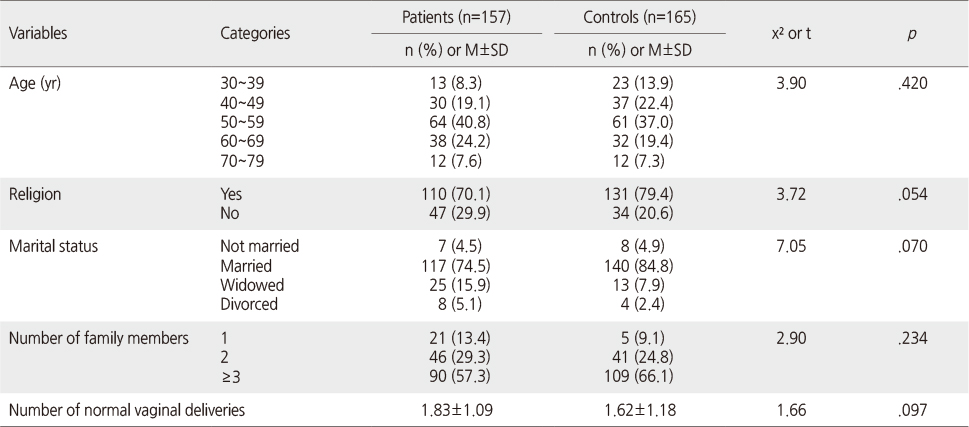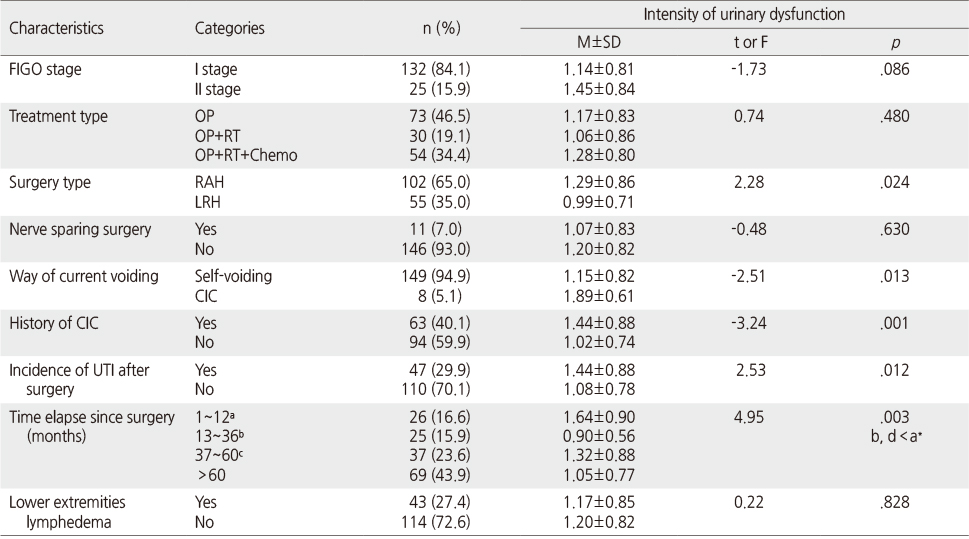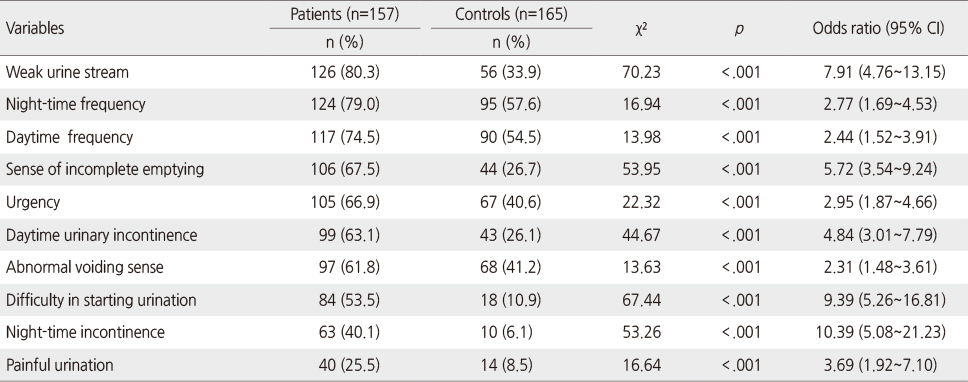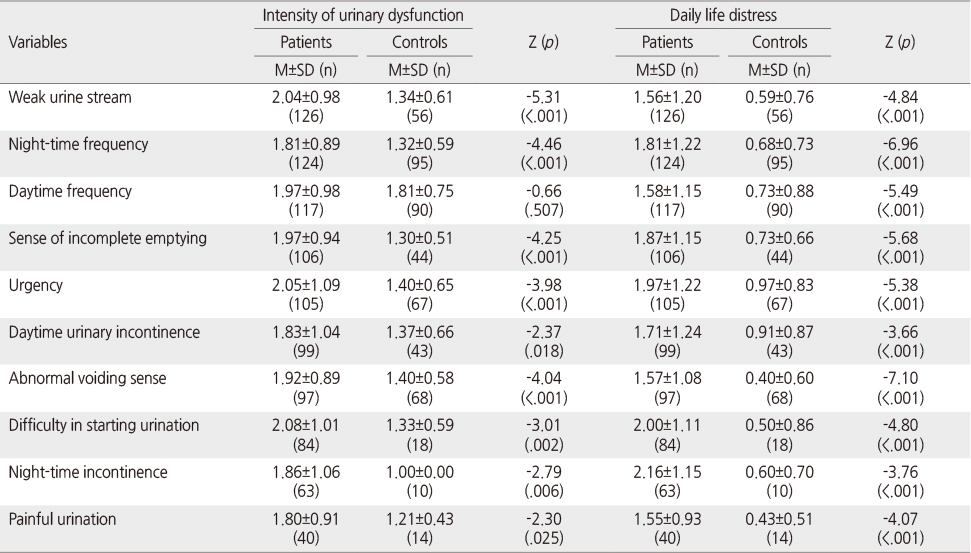Articles
- Page Path
- HOME > J Korean Acad Nurs > Volume 46(3); 2016 > Article
-
Original Article
- Frequency, Intensity and Daily Life Distress of Urinary Dysfunction in Women with Cervical Cancer after Radical Hysterectomy
- Nami Chun, Gie Ok Noh, Hyun Ju Song, Sang Hee Kim
-
Journal of Korean Academy of Nursing 2016;46(3):400-408.
DOI: https://doi.org/10.4040/jkan.2016.46.3.400
Published online: June 30, 2016
1Department of Nursing, Sungshin Women's University, Seoul, Korea.
2Department of Nursing, Samsung Medical Center, Seoul, Korea.
- Address reprint requests to: Noh, Gie Ok. Department of Nursing, Sungshin Women's University, 76ga-gil Dobong-ro, Gangbuk-gu, Seoul 01133, Korea. Tel: +82-2-920-7789, Fax: +82-2-920-2092, nkorn91@gmail.com
© 2016 Korean Society of Nursing Science
This is an Open Access article distributed under the terms of the Creative Commons Attribution NoDerivs License. (http://creativecommons.org/licenses/by-nd/4.0/) If the original work is properly cited and retained without any modification or reproduction, it can be used and re-distributed in any format and medium.
Abstract
-
Purpose
- This study was done to identify frequency, intensity of urinary dysfunction and daily life distress in women after a radical hysterectomy for cervical cancer.
-
Methods
- One hundred and fifty seven women who had undergone a radical hysterectomy and one hundred and sixty five women as healthy controls completed questionnaires on intensity of urinary dysfunction and daily life distress caused by urinary dysfunction.
-
Results
- Women with cervical cancer showed higher frequency of urinary dysfunction than healthy controls. Major urinary dysfunction for women with cervical cancer in order of frequency were night-time incontinence (odds ratio=10.39, p<.001), difficulty in starting urination, weak urine stream and sense of incomplete emptying of bladder. The highest score on intensity was difficulty in starting urination, followed by urgency, weak urine stream, daytime frequency and sense of incomplete emptying. Night-time incontinence was the urinary symptom causing the most daily life distress for cervical cancer women followed by difficulty in starting urination, urgency, sense of incomplete emptying, and night-time frequency.
-
Conclusion
- Results suggest that nurses should address the potential postoperative urinary complications and develop long term interventions to decrease urinary dysfunction and daily life distress for women who have had a radical hysterectomy for cervical cancer.
This study was supported by Sungshin Women's University research fund in 2014 (No.: 2014-2-21-003)
The authors declared no conflict of interest.
- 1. Ministry of Health & Welfare, Korea Central Cancer Registry, National Cancer Center. Annual report of cancer statistics in Korea in 2011. Seoul: Ministry of Health & Welfare; 2013.
- 2. Berek JS. Berek and Novak's gynecology. 15th ed. Philadelphia, PA: Lippincott Williams and Wilkins; 2011. p. 1304–1345.
- 3. Kashima K, Yahata T, Fujita K, Tanaka K. Analysis of the complications after radical hysterectomy for stage IB, IIA and IIB uterine cervical cancer patients. J Obstet Gynaecol Res. 2010;36(3):555–559. ArticlePubMed
- 4. Likic IS, Kadija S, Ladjevic NG, Stefanovic A, Jeremic K, Petkovic S, et al. Analysis of urologic complications after radical hysterectomy. Am J Obstet Gynecol. 2008;199(6):644.e1–644.e3. ArticlePubMed
- 5. Charoenkwan K, Pranpanas S. Prevalence and characteristics of late postoperative voiding dysfunction in early-stage cervical cancer patients treated with radical hysterectomy. Asian Pac J Cancer Prev. 2007;8(3):387–389.PubMed
- 6. Bergmark K, Avall-Lundqvist E, Dickman PW, Henningsohn L, Steineck G. Lymphedema and bladder-emptying difficulties after radical hysterectomy for early cervical cancer and among population controls. Int J Gynecol Cancer. 2006;16(3):1130–1139. ArticlePubMed
- 7. Todo Y, Kuwabara M, Watari H, Ebina Y, Takeda M, Kudo M, et al. Urodynamic study on postsurgical bladder function in cervical cancer treated with systematic nerve-sparing radical hysterectomy. Int J Gynecol Cancer. 2006;16(1):369–375. ArticlePubMed
- 8. Hwang JH. Urologic complication in laparoscopic radical hysterectomy: Meta-analysis of 20 studies. Eur J Cancer. 2012;48(17):3177–3185. ArticlePubMed
- 9. Chuang FC, Kuo HC. Management of lower urinary tract dysfunction after radical hysterectomy with or without radiotherapy for uterine cervical cancer. J Formos Med Assoc. 2009;108(8):619–626. ArticlePubMed
- 10. Behtash N, Ghaemmaghami F, Ayatollahi H, Khaledi H, Hanjani P. A case-control study to evaluate urinary tract complications in radical hysterectomy. World J Surg Oncol. 2005;3(1):12ArticlePubMedPMCPDF
- 11. Manchana T, Prasartsakulchai C, Santingamkun A. Long-term lower urinary tract dysfunction after radical hysterectomy in patients with early postoperative voiding dysfunction. Int Urogynecol J. 2010;21(1):95–101. ArticlePubMedPDF
- 12. Laterza RM, Sievert KD, de Ridder D, Vierhout ME, Haab F, Cardozo L, et al. Bladder function after radical hysterectomy for cervical cancer. Neurourol Urodyn. 2015;34(4):309–315. ArticlePubMed
- 13. Song HJ. Effect of a bladder training program using internet self catheterization on voiding dysfunction of patients who have received a radical abdominal hysterectomy [master's thesis]. Seoul, Yonsei University. 1999;1–54.
- 14. Faul F, Erdfelder E, Buchner A, Lang AG. Statistical power analyses using G*Power 3.1: Tests for correlation and regression analyses. Behav Res Methods. 2009;41(4):1149–1160. ArticlePubMedPDF
- 15. Korean Continence Society. Textbook of female urology and urogynecology. 2nd ed. Seoul: Ilchokak; 2009. p. 101–132.
- 16. Kim SH. The association between expectations regarding aging and health-promoting behaviors among Korean older adults. J Korean Acad Nurs. 2007;37(6):932–940.ArticlePDF
- 17. Suh DH, Cho HY, Kim K, No JH, Kim YB. Matched-case comparisons in a single institution to determine critical points for inexperienced surgeons' successful performances of laparoscopic radical hysterectomy versus abdominal radical hysterectomy in stage IA2-IIA cervical cancer. PLoS One. 2015;10(6):e0131170ArticlePubMedPMC
- 18. Lee EJ, Kang H, Kim DH. A comparative study of laparoscopic radical hysterectomy with radical abdominal hysterectomy for early-stage cervical cancer: A long-term follow-up study. Eur J Obstet Gynecol Reprod Biol. 2011;156(1):83–86. ArticlePubMed
- 19. Park JY, Kim DY, Kim JH, Kim YM, Kim YT, Nam JH. Laparoscopic versus open radical hysterectomy for elderly patients with early-stage cervical cancer. Am J Obstet Gynecol. 2012;207(3):195.e1–195.e8. ArticlePubMed
- 20. Rob L, Halaska M, Robova H. Nerve-sparing and individually tailored surgery for cervical cancer. Lancet Oncol. 2010;11(3):292–301. ArticlePubMed
- 21. Tseng CJ, Shen HP, Lin YH, Lee CY, Wei-Cheng Chiu W. A prospective study of nerve-sparing radical hysterectomy for uterine cervical carcinoma in Taiwan. Taiwan J Obstet Gynecol. 2012;51(1):55–59. ArticlePubMed
- 22. Gil-Ibáñez B, Díaz-Feijoo B, Perez-Benavente A, Puig-Puig O, Franco-Camps S, Centeno C, et al. Nerve sparing technique in robotic-assisted radical hysterectomy: Results. Int J Med Robot. 2013;9(3):339–344. ArticlePubMedPDF
- 23. Maneschi F. Urodynamic study of bladder function following nerve sparing radical hysterectomy. J Gynecol Oncol. 2014;25(3):159–161. ArticlePubMedPMC
- 24. Heo KO. A study of women's life-distress by voiding dysfunction [dissertation]. Seoul, Hanyang University. 2009;1–84.
REFERENCES
Figure & Data
REFERENCES
Citations

- Evaluation of pelvic floor muscle function (PFMF) in cervical cancer patients with Querleu–Morrow type C hysterectomy: a multicenter study
Shiyan Wang, Lei Gao, Hongwu Wen, Yunong Gao, Qiubo Lv, Hongyu Li, Sumei Wang, Yanlong Wang, Qing Liu, Jinsong Han, Haibo Wang, Yi Li, Na Yu, Qing Wang, Tingting Cao, Sha Wang, Huaxin Sun, Zhiqi Wang, Xiuli Sun, Jianliu Wang
Archives of Gynecology and Obstetrics.2022; 305(2): 397. CrossRef - Association of pelvic floor function with postoperative urinary incontinence in cervical cancer patients after the radical hysterectomy
Shiyan Wang, Runzhi Wang, Hongwu Wen, Yunong Gao, Qiubo Lv, Hongyu Li, Sumei Wang, Yanlong Wang, Qing Liu, Jinsong Han, Haibo Wang, Yi Li, Qing Wang, Tingting Cao, Sha Wang, Huaxin Sun, Zhiqi Wang, Xiuli Sun, Jianliu Wang
Neurourology and Urodynamics.2021; 40(1): 483. CrossRef - Influence of Urinary Dysfunction on Quality of Life in Women with Cervical Cancer after Radical Hysterectomy
Nami Chun, Gie-Ok Noh
Asian Oncology Nursing.2019; 19(3): 150. CrossRef - Symptom Distress and Depression in Patients with Recurrent Gynecologic Cancer Undergoing Chemotherapy: Mediating Effect of Resilience
Eun Jung Yang, Ho Sihn Ryu
Korean Journal of Adult Nursing.2019; 31(1): 28. CrossRef
Homogeneity of General Characteristics between Patient and Control Group (N=322)
Differences in Intensity of Urinary Dysfunction according to Medical Characteristics in Women with Cervical Cancer (N=157)
*Scheffé post hoc; FIGO=International Federation of Gynecology and Obstetrics; RT=Radiation therapy; RAH=Radical abdominal hysterectomy; LRH=Laparoscopic radical hysterectomy; CIC=Clean intermittent catheterization; UTI=Urinary tract infection.
Difference in Frequency of Urinary Dysfunction between Patient and Control Group (N=322)
Difference in Intensity of Urinary Dysfunction and Daily Life Distress between Patient and Control Group
*Scheffé post hoc; FIGO=International Federation of Gynecology and Obstetrics; RT=Radiation therapy; RAH=Radical abdominal hysterectomy; LRH=Laparoscopic radical hysterectomy; CIC=Clean intermittent catheterization; UTI=Urinary tract infection.
 KSNS
KSNS
 E-SUBMISSION
E-SUBMISSION




 Cite
Cite

